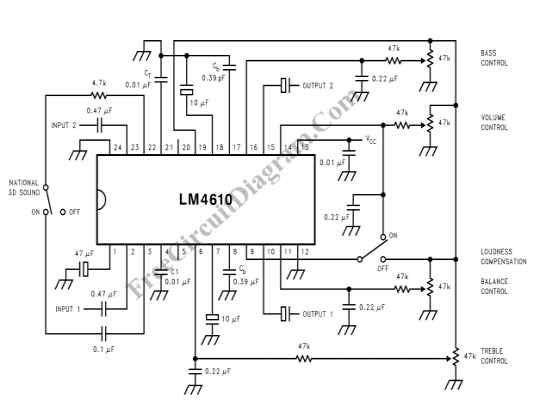Stereo Tone Control with National 3D Sound

The LM4610 uses DC signal to control the tone (bass/treble), volume, and balance circuit. The advantages of using DC control is that you can use a mono potentiometer to control both channel, even you can use a DC signal generated from a DAC, so you can control the sound using microcontroller or microprocessor. This circuit can applied for car radio, TV, or any audio system. It also features National’s 3D-Sound Circuitry which can be externally adjusted via a simple RC Network. An additional control input allows loudness compensation to be simply effected. Each tone response is defined by a single capacitor chosen to give the desired characteristic. Here is the schematic diagram of the circuit:

The key fetures of the LM4610 are:
- Wide supply voltage range, 9V to 16V
- National 3-D Sound
- Tone control, ±15 dB typical
- Large volume control range, 75 dB typical
- Low distortion, 0.06% typical for an input level of 0.3 Vrms
- Channel separation, 75 dB typical
- Few external components required
- High signal to noise, 80 dB typical for an input level of 0.3 Vrms
NATIONAL 3D-SOUND
If the stereo speakers should be located closer because space limitation,phase reversed interchannel cross coupling can be used to improve the more realistic stereo effect. This is done by connecting external resistor (4.7k) in series with capacitor (0.1uF) across pin 3 and pin 22 of the LM4610 chip. This component values gives an optimum 60% cross coupling level. At low frequencies, speakers become less directional and it becomes desirable to reduce the enhancement effect. With a 0.1µF coupling capacitor, as shown, roll-off occurs below 330 Hz. The coupling components can be varied to change the responses. [Source: National Semiconductor Application Notes]